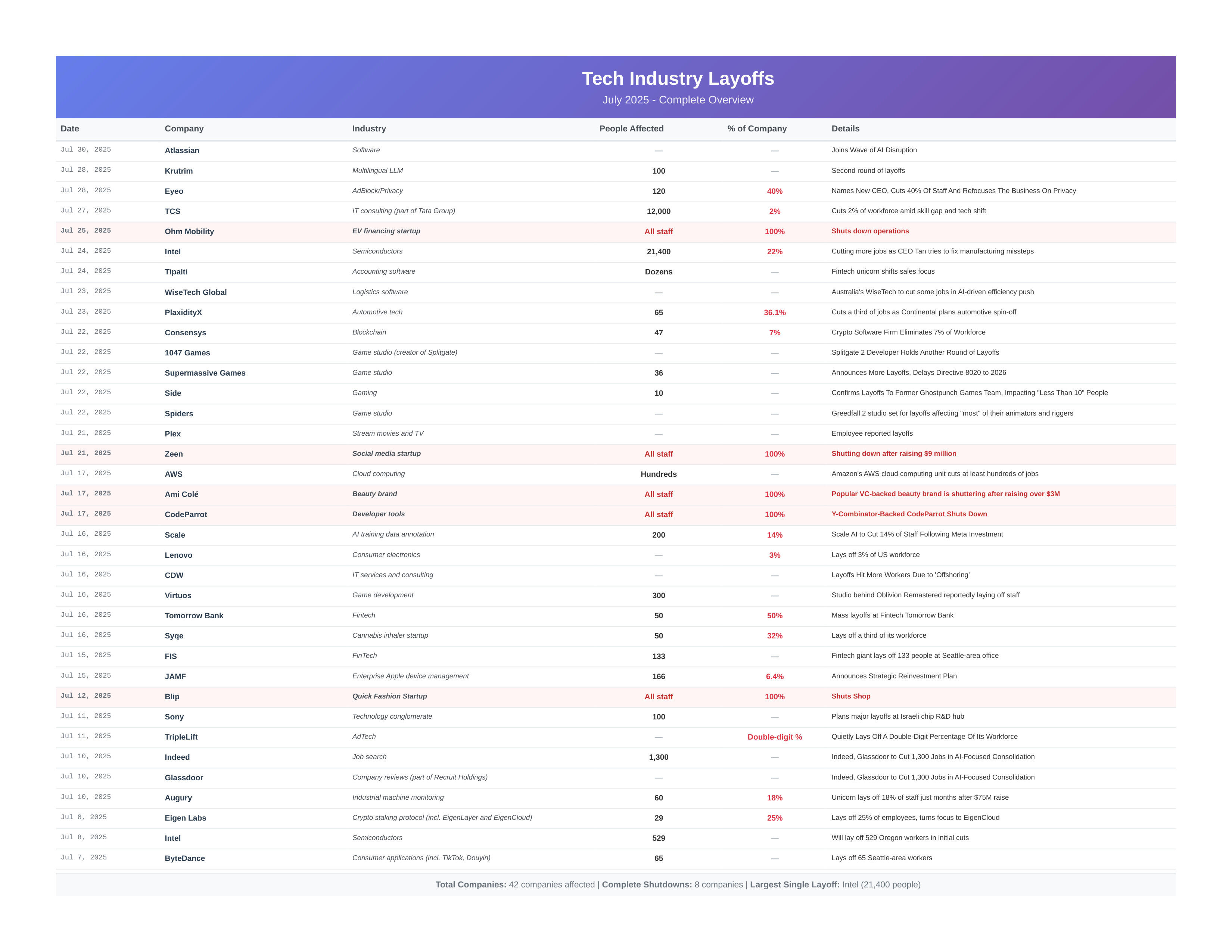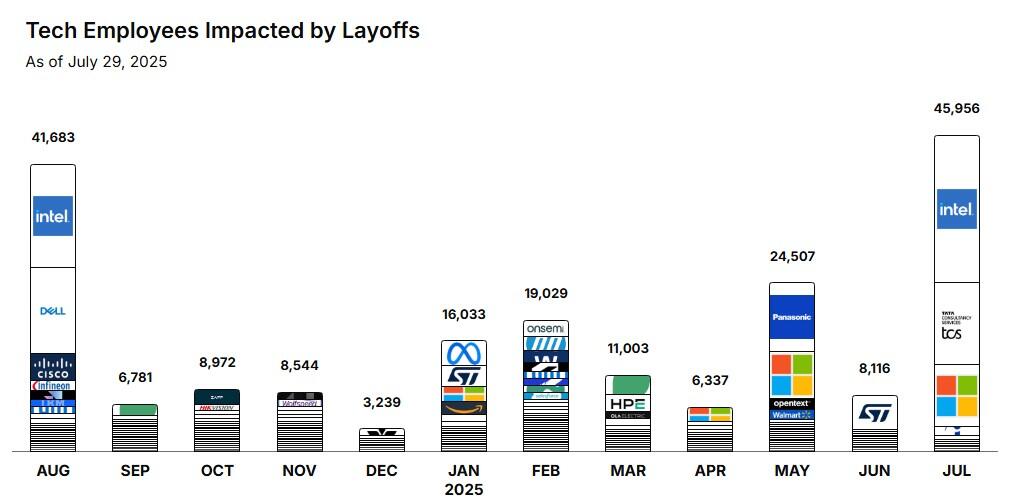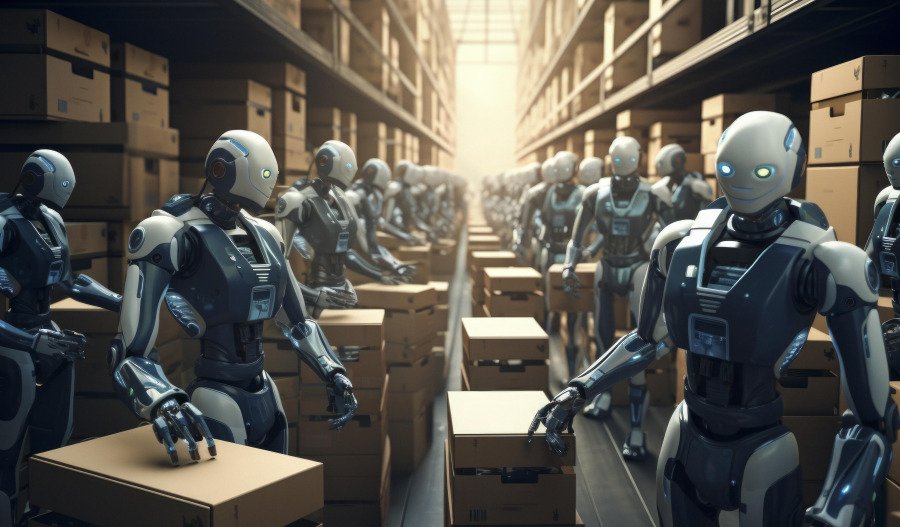Artificial intelligence displaced over 137,000 workers across 434 tech layoffs globally during FY25, including a 35% rise in United States' job cuts year-over-year alone, signalling profound market disruptions across the board.
This surge in lay-offs underscores how companies invest billions in AI to boost efficiency - yet amplify unemployment risks in vulnerable sectors.
The tech giants creating the AI models lead the charge, driven by economic pressures and AI automation streamlining operations.
Microsoft has eliminated up to 20,000 roles amid AI integrations in cloud services this year, while Intel cut 24,000 positions to pivot towards AI chip manufacturing.
Meta reduced its workforce by 21,000 to fund generative AI tools that automate content moderation.
Additional examples include Amazon shedding 27,000 jobs through AI agents in fulfilment centres and Google trimming 12,000 via efficiency tools.
These moves reflect a competitive landscape where AI adoption cuts operational costs by up to 30%, says McKinsey.
77% of the FY25 layoffs cite "efficiency" or "restructuring" - sneaky code for AI implementation, exacerbating a skills mismatches in the labour market.
An eye-whopping 46,000+ specialised tech workers were made redundant during July alone, TrueUp data revealed.

A handful of those in the list were startups such as Ohm Mobility that saw the writing on the wall and have shutdown completely.
Sectors hit hardest by AI displacement
Out of last financial year's 137,000 jobs lost to AI-driven downsizing, tech domninates the trend with 94,000 employees canned across software engineering, HR and customer support functions.
The finance sector follows closely - banks like Klarna now automate 94% of HR tasks via AI, slashing operation costs.
TrueUp also notes that consumer tech and enterprise software sub-sectors account for 45% of those tech cuts, with roles in mid-level management and data entry vanishing into thin air as AI handles the routine analytics.
Content creation and administrative positions suffer too, with generative AI tools replacing entry-level workers.
Emerging patterns indicate a 20% increase in AI-specific mentions in layoff announcements compared to 2024, as the tech becones an integral part of corporate strategy.

More bad news: Roughly 41% of global employers said they would be making AI-related reductions by 2030, according to the World Economic Forum.
This trend intensifies competition, with firms reallocating savings and expenditure into AI R&D budgets exceeding $200 billion annually.
TrueUp says that momentum will continue into Q3 this year, with potentially 30,000 more layoffs if macroeconomic conditions persist.
Sectors poised for AI disruption
Manufacturing faces imminent threats, with AI projected to eliminate 1.7 million global jobs through robotic automation by 2026.
Retail and wholesale sectors also anticipate shifts, as AI streamlines inventory and sales forecasting, potentially displacing 300 million full-time equivalents worldwide.
There's also notable early signs of non-tech firms adopting AI, such as logistics companies reducing warehouse staff by 15% via predictive algorithms.
Construction, agriculture, and food processing have emerged as vulnerable too, with AI boosting productivity and reducing labour needs for repetitive tasks.
While business and financial operations could see enhanced efficiencies, entry-level roles in data entry are vanishing rapidly.
Governments worldwide are urging companies to update their policies to implement retraining, as data is emerging that U.S. unemployment lingers longer for AI-affected workers, with average job search durations extending to six months.
Parallels with historical technological shifts
Looking back in time, we can see past innovations mirroring AI's dual impact.
For instance, the Industrial Revolution displaced artisan weavers when mechanised looms reduced their numbers by thousands in the 19th century, sparking poverty and unrest.
However, the same innovation also spurred 85% employment growth in the textiles sector since 1940, creating roles in factories and other services.
Historians also note that while initial displacement did lead to considerable social upheaval during that period, the long-term benefits included urbanisation and higher wages for skilled labour.
Then there's the IT revolution which automated routine cognitive tasks - eliminating two to three jobs per robot in manufacturing from 1980 to 2010.
Despite this, technological advances have since generated 60% of new job types in the U.S. alone in the last 85 years, according to MIT research.
Overall, history shows net societal gains as productivity rose, living standards improved and economies expanded each time.
What's different on this seismic technological shift, is that AI is being adopted at a frightening pace, compressing the transition periods from decades to years.
On a positive note, research does suggest that while 88 million jobs globally may displace this year, 97 million new ones in AI ethics and data science could emerge, yielding net gains outcomes - if the transitions are managed well.
Regions with strong education systems - such as Europe - may see quicker re-employment in emerging AI roles.
Other continents, such as Africa and South America, are likely to feel considerably larger unemployment woes in the short to mid terms.
Market implications
AI-driven displacement also reshapes business strategies, and we're already seeing companies like Microsoft have its share price climb 15% amid efficiency gains.
Intel's stock did dip 10% post-layoffs, but it's pegged to rebound on AI chip demand forecasts.
While the data indicates companies that embrace AI early will achieve 20% higher profit margins, they'll also face talent shortages in specialised fields.
Globally, while the trend positions leaders in AI to dominate, it heightens the need for regulatory scrutiny over company labour policies.
Rightly or wrongly, it's a no-brainer that firms which invest in upskilling secure competitive advantages and mitigate risks in a market trending towards $15.7 trillion in AI economic contributions by 2030.



